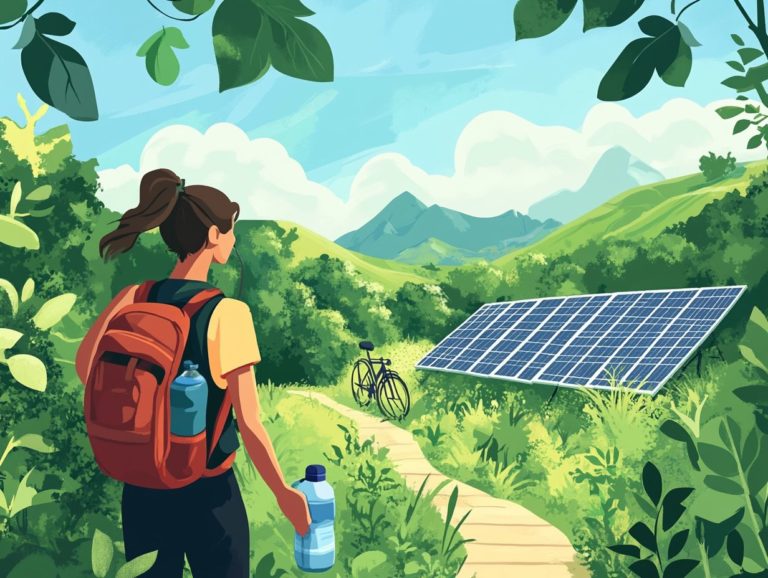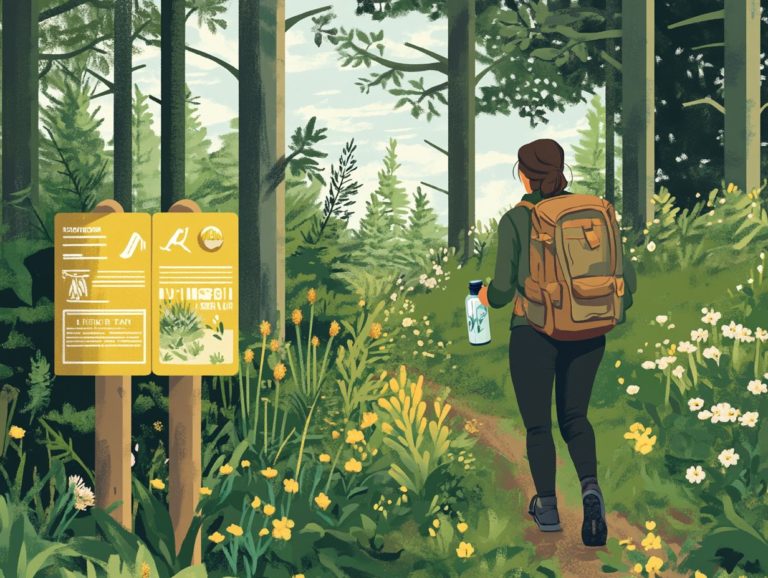Tips for Eco-Friendly Travel in National Parks
As you embark on your journey through the breathtaking landscapes of national parks, embracing eco-friendly practices becomes essential.
This exploration highlights the significance of preserving these natural wonders while fully enjoying their offerings. You will find practical tips to help you travel sustainably, from reducing your carbon emissions to packing sustainably and practicing responsible camping and hiking.
Discover how to support local conservation efforts through community support, select eco-friendly accommodations, and participate in activities that honor and protect the planet. Join in the commitment to keeping these majestic spaces unspoiled for generations to come.
Contents
- Key Takeaways:
- The Importance of Eco-Friendly Travel in National Parks
- Reducing Your Carbon Footprint
- Responsible Camping and Hiking Practices
- Supporting Local Conservation Efforts
- Eco-Friendly Activities in National Parks
- Choosing Eco-Friendly Accommodations
- Final Thoughts on Eco-Friendly Travel
- Frequently Asked Questions
- What are some general tips for eco-friendly travel in national parks?
- How can I reduce my carbon footprint while visiting a national park?
- What are some ways to conserve water while camping in a national park?
- Are there any eco-friendly accommodations available in national parks?
- What should I do if I encounter wildlife while exploring a national park?
- Are there any specific regulations I should be aware of while visiting a national park?
Key Takeaways:
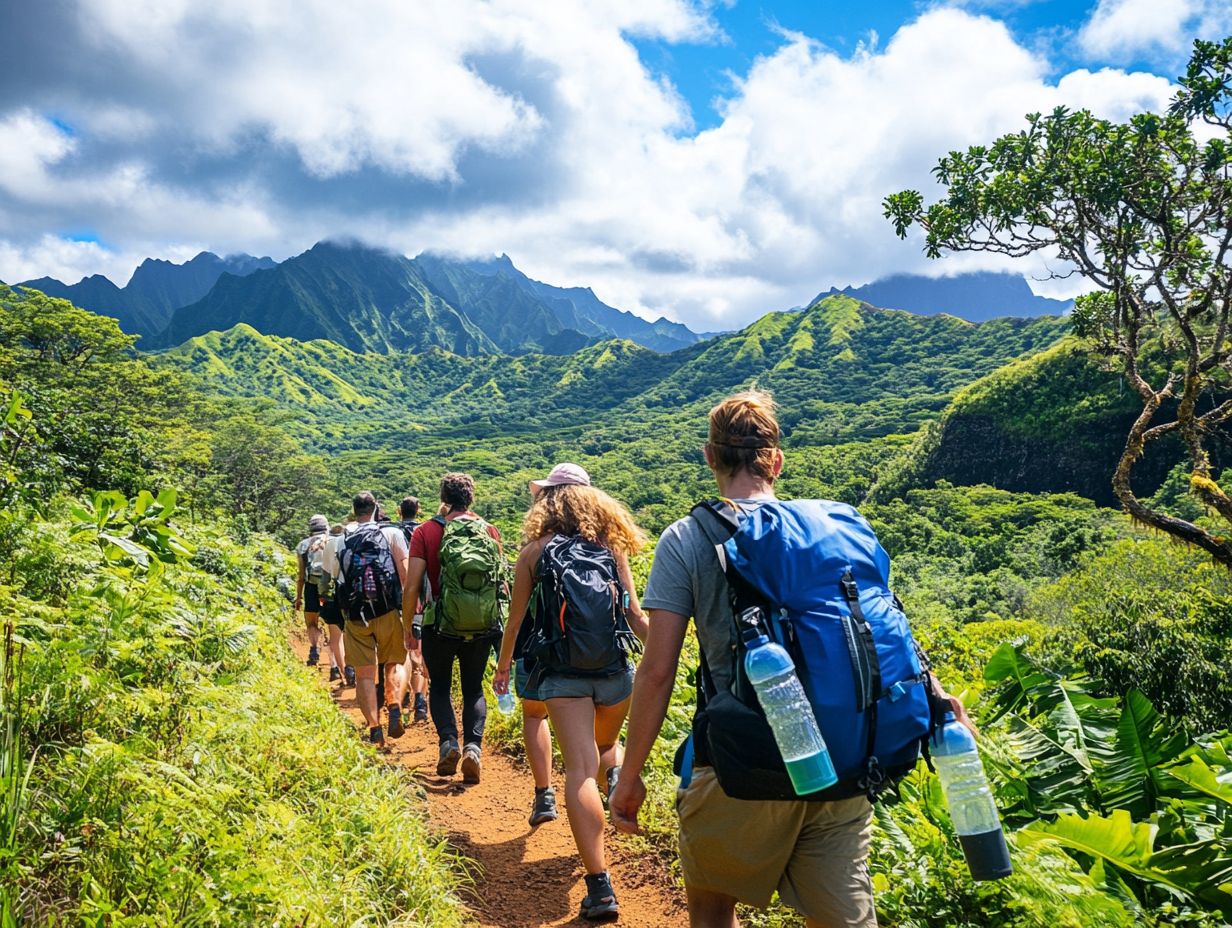
- Choose alternative transportation options to reduce carbon emissions when traveling to national parks.
- Practice responsible camping and hiking by following Leave No Trace principles, which help preserve the natural environment.
- Support local conservation efforts by volunteering and donating to help protect national parks for future generations.
The Importance of Eco-Friendly Travel in National Parks
Eco-friendly travel in national parks is essential for preserving the environment and enriching your experience while minimizing your ecological footprint. When you practice sustainability, you help protect the delicate ecosystems within these natural treasures, ensuring that future generations can also revel in their beauty.
The National Park Service (NPS) champions green initiatives that promote responsible behavior among visitors, emphasizing adherence to park guidelines and support for local communities.
As you explore these magnificent national parks, recognizing the environmental impact of your actions is crucial to fostering a culture of sustainability.
Reducing Your Carbon Footprint
Reducing your carbon footprint while exploring national parks is crucial in the battle against climate change. There are countless ways to embrace sustainable travel practices. By being mindful of your choices, you can dramatically reduce your carbon emissions and contribute to a healthier planet.
Opting for sustainable transportation options like biking, walking, or carpooling can make a meaningful difference in greenhouse gas emissions during your adventures.
Choosing alternative travel methods enhances your connection with nature and supports eco-friendly travel initiatives.
Alternative Transportation Options
Exploring alternative transportation options can significantly elevate your eco-friendly travel experience in national parks while effectively reducing carbon emissions. Many parks now provide bike rentals, shuttle services, and designated walking trails, allowing you to fully immerse yourself in nature while respecting park guidelines.
By choosing sustainable transportation methods, you lessen your environmental impact and deepen your connection with the breathtaking surroundings, making your visit even more memorable.
These alternative modes of transport promote a healthier lifestyle and play a crucial role in conserving the stunning landscapes that draw visitors in. Shuttles make it easier to access popular areas without the stress of finding parking, letting you focus on the wildlife and gorgeous vistas. Meanwhile, biking and walking empower you to explore at your own pace, creating opportunities for a more intimate engagement with nature.
Choosing greener options helps protect wildlife habitats and the overall health of the ecosystems within the parks.
Packing Sustainably
Packing sustainably for your trip to a national park can significantly reduce your environmental footprint while enhancing your overall experience.
The secret lies in packing light and including essentials like reusable water bottles, which help cut down on single-use plastics and minimize waste.
By thinking carefully about what you pack and practicing proper waste disposal during your visit, you play a vital role in the park’s conservation efforts and support eco-friendly travel initiatives.
Along with reusable items, consider choosing biodegradable toiletries and eco-friendly snacks with minimal packaging. These selections not only lower your carbon footprint but also bolster local economies, especially if you source food from nearby shops.
Every thoughtful decision you make can turn your travel habits into a more sustainable routine. Packing light encourages mindfulness, allowing you to truly appreciate your surroundings without the burden of excess baggage.
This approach simplifies your journey and aligns with the principles of responsible tourism, ensuring that future generations can revel in the breathtaking beauty of these natural landscapes.
Responsible Camping and Hiking Practices
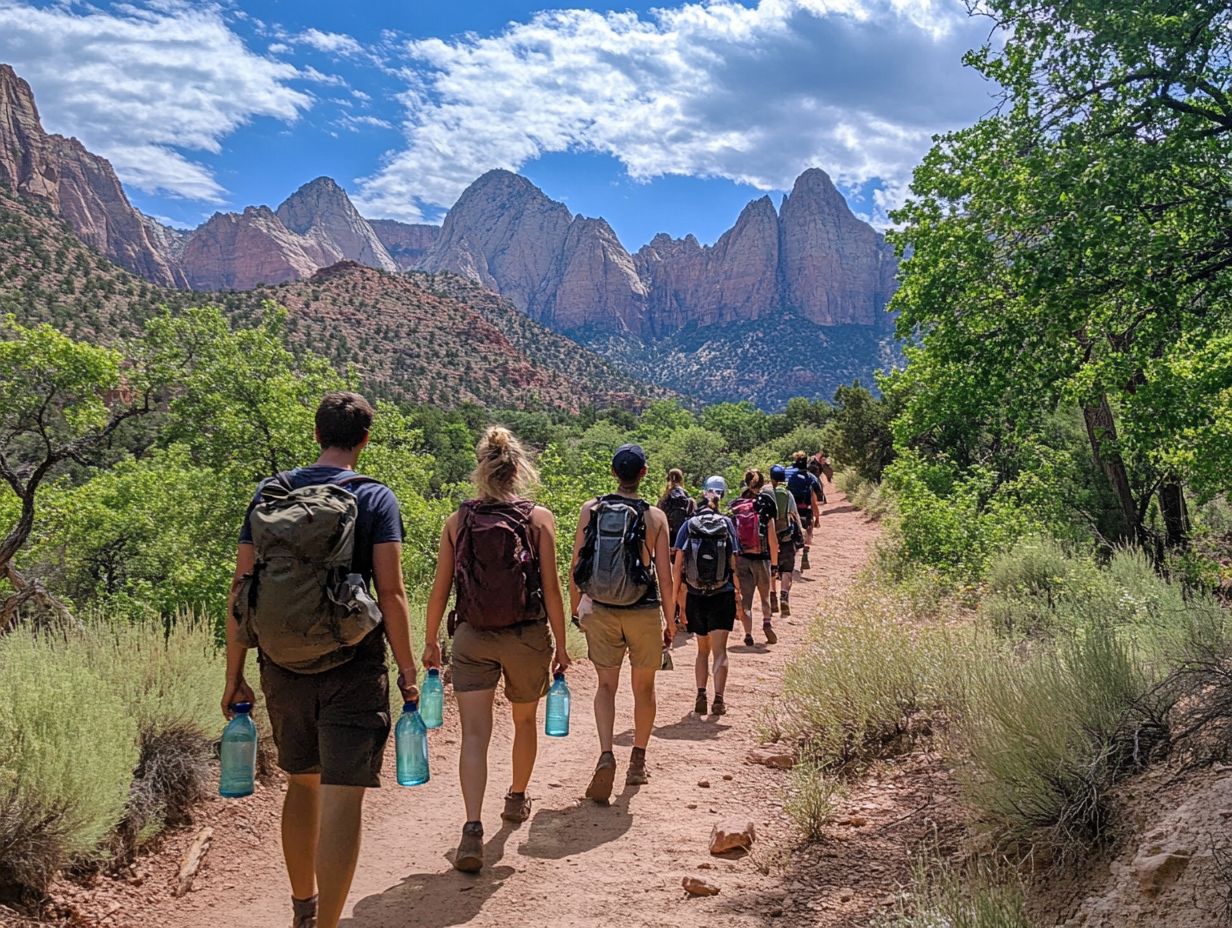
Embracing responsible camping and hiking practices is essential for preserving the breathtaking beauty of our national parks while ensuring a positive experience for both visitors and wildlife.
The Leave No Trace principles serve as your compass, guiding you on how to minimize your environmental impact as you enjoy the great outdoors.
By respecting wildlife interactions and adhering to proper waste disposal methods, you play a vital role in safeguarding the ecosystems that thrive in these pristine areas.
Understanding and following park guidelines is crucial for cultivating a sustainable relationship with nature.
Leave No Trace Principles
The Leave No Trace principles provide you with easy-to-follow guidelines designed to help outdoor enthusiasts like yourself minimize environmental impact while enjoying the beauty of national parks.
These principles underscore the significance of proper waste disposal, respectful wildlife interactions, and adherence to park regulations, all aimed at preserving the delicate ecosystems you encounter.
By embracing these guidelines, you can actively contribute to the protection of our natural resources while enjoying a fulfilling outdoor adventure.
These principles create a framework for responsible recreation and highlight the importance of local shopping to support local economies, ensuring that the breathtaking allure of our national parks remains accessible to future generations.
For instance, when you plan ahead and prepare for your hikes, you significantly decrease the chances of forging new trails that disrupt habitats.
Staying on designated paths is not just a courtesy; it protects delicate flora and reduces soil erosion.
It’s crucial for you to pack out all trash, including food scraps, to prevent wildlife from being attracted to human waste.
Keeping a respectful distance from animals allows them to thrive in their natural environments, maintaining the delicate balance of the ecosystem.
These small yet impactful choices lead to a more sustainable and rewarding outdoor experience.
Supporting Local Conservation Efforts
Supporting local conservation efforts in national parks is essential for preserving the natural environment and enriching your overall visitor experience.
By engaging with community support initiatives, you can make a positive impact on the local economy while helping to maintain the park’s delicate ecosystems.
Whether you choose to volunteer for park clean-up events or donate to organizations dedicated to conservation, your contributions ensure that these national treasures continue to thrive for future generations.
These actions not only benefit the parks but also cultivate a deeper connection between you and the environment, enhancing your journey in ways that go beyond mere sightseeing.
Volunteering and Donating
Volunteering and donating are powerful ways to help conserve national parks and their communities.
Organizations welcome volunteers for tasks like park clean-ups and educational outreach programs. These efforts are vital for sustaining our natural environment.
When you donate to local conservation groups, you provide much-needed funding for projects aimed at preserving the beauty and integrity of national parks.
Your involvement can make a real difference in both the local economy and the ecosystems within these treasured spaces.
For instance, organizations like the National Park Foundation and local park conservancies often have structured programs that invite you to engage directly in conservation efforts.
By volunteering for tasks such as invasive species removal or wildlife monitoring, you help maintain biodiversity, benefiting both flora and fauna.
Your donations are vital. They help fund maintenance projects and educational programs that foster appreciation for natural habitats.
Even small contributions can significantly support important scientific research leading to more effective conservation strategies.
Eco-Friendly Activities in National Parks
Participating in eco-friendly activities during your visits to national parks can elevate your travel experience while championing sustainable practices.
By engaging in eco-tours, you immerse yourself in the park’s breathtaking beauty and vibrant wildlife, gaining a deeper understanding of its ecosystems.
Educational programs provide important insights into conservation efforts and emphasize the importance of preserving these precious environments.
When you choose eco-friendly activities, you contribute to the goal of being eco-friendly and cultivate a profound connection with nature itself.
Eco-Tours and Educational Programs
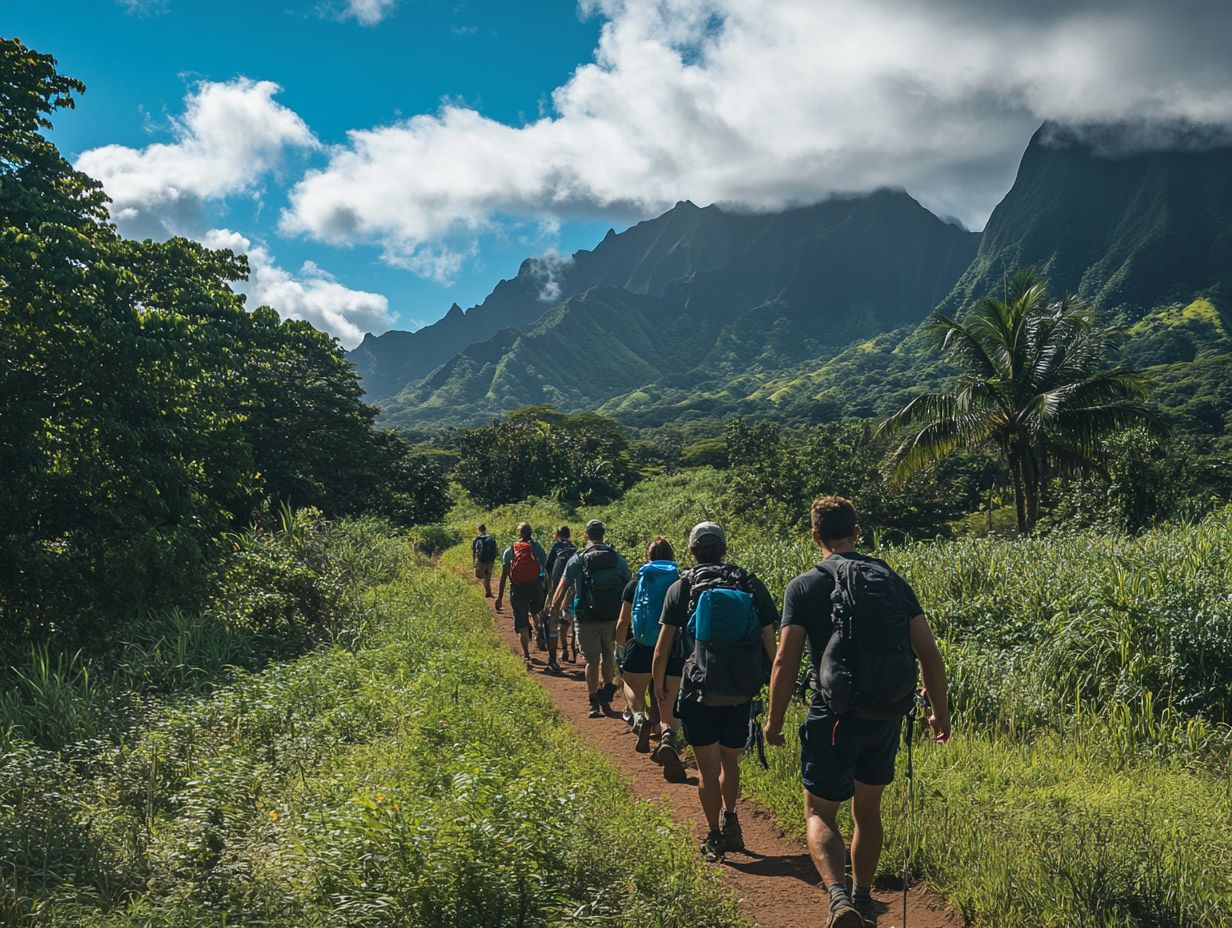
Eco-tours and educational programs in national parks offer unique opportunities to explore and learn about the natural environment while embracing eco-friendly travel.
These guided experiences often center around wildlife interactions and ecosystem preservation, instilling a sense of responsibility toward nature within you.
By participating in these programs, you deepen your understanding of the park’s ecological significance and contribute to sustainable tourism efforts.
Eco-tours are not only educational; they also cultivate a profound appreciation for the natural beauty of our planet.
With options ranging from birdwatching excursions to hands-on conservation workshops, these programs cater to various interests and age groups.
Some eco-tours highlight the importance of native species, guiding you in identifying local flora and fauna while documenting your findings.
Other educational initiatives may feature expert-led sessions on geological formations or climate change, illustrating how ecosystems adapt to shifting environmental forces.
These activities enhance your knowledge and nurture a collaborative spirit, as many programs encourage you to engage in actual conservation efforts.
By immersing yourself in these enriching experiences, you forge lasting memories and become an advocate for the protection and preservation of our cherished landscapes.
Choosing Eco-Friendly Accommodations
Choosing eco-friendly accommodations during your visits to national parks is essential for promoting sustainability and minimizing your environmental footprint.
You ll find a wealth of options, from traditional camping and glamping experiences to eco-friendly lodges and hotels that prioritize green practices.
By opting for lodgings that emphasize sustainable operations like energy conservation and waste reduction you can enjoy your stay while actively supporting the preservation of the natural environment.
These thoughtful choices enrich your experience and play a crucial role in maintaining the health of our ecosystems.
Camping and Glamping Options
Camping and glamping options in national parks offer unique and sustainable ways to immerse yourself in the great outdoors while championing eco-friendly travel.
Traditional camping envelops you in the wilderness with basic amenities, fostering a genuine connection with nature. In contrast, glamping elevates your experience by incorporating comfort and style. Imagine waking up in a circular tent that s often eco-friendly, complete with solar-powered lighting it s outdoor living redefined. Both experiences emphasize the vital importance of minimizing waste and preserving natural resources.
As a camper, you ll acquire essential skills for outdoor survival and stewardship. In glamping communities, the focus shifts to sustainable materials and practices.
Ultimately, choosing between these two options tailors your adventure. Whether you yearn for simplicity or crave a few extra amenities, you can enjoy breathtaking landscapes and wildlife without leaving a negative mark on the delicate ecosystems around you.
Eco-Friendly Lodges and Hotels
Eco-friendly lodges and hotels in national parks are increasingly popular as travelers seek places to stay that reflect their values and commitment to sustainability. These establishments prioritize eco-consciousness by implementing green practices, such as energy-efficient designs and waste reduction initiatives.
Choosing these eco-friendly options not only minimizes your carbon footprint; it actively contributes to the preservation of the local ecosystem. Many of these places feature locally sourced materials, organic meals, and renewable energy solutions, allowing you to indulge in luxurious comforts while remaining in harmony with nature.
For example, lodges nestled in Yellowstone offer guided hikes focused on wildlife conservation, enriching your understanding of the surrounding environment. With their dedication to reducing waste and supporting local communities, eco-friendly hotels serve as an inspiring model for responsible tourism, encouraging you to make mindful choices during your adventures. Consider participating in the top 10 eco-conscious activities in national parks for a truly enriching experience.
Final Thoughts on Eco-Friendly Travel
Embracing sustainability during your visits to national parks is essential. This commitment not only helps protect the environment but also enriches your travel experience. By consciously opting for eco-friendly practices, you can significantly reduce your environmental impact while supporting local communities.
Your actions can spark a movement towards conservation and sustainability, ensuring these national treasures remain intact for generations to come.
By adopting simple strategies like reducing waste, utilizing public transportation, and engaging with local eco-friendly businesses, you can make a meaningful difference. Each action, whether it’s choosing reusable water bottles or participating in park clean-up activities, reinforces the idea that top sustainable travel practices are a shared responsibility.
This approach mitigates the adverse effects of overtourism and deepens your connection to the natural world.
When you choose to travel responsibly, you play a crucial role in preserving the beauty and integrity of national parks, paving the way for a brighter future for both the environment and the communities that depend on them.
Frequently Asked Questions

What are some general tips for eco-friendly travel in national parks?
Some general tips include packing out all trash, using reusable containers and water bottles, staying on designated trails, and avoiding single-use items.
How can I reduce my carbon footprint while visiting a national park?
You can reduce your carbon footprint by walking or biking instead of driving, using public transportation, and participating in eco-friendly activities like guided hikes or wildlife observation.
Join the movement for a greener planet start your eco-friendly adventure today!
What are some ways to conserve water while camping in a national park?
Conserving water while camping is essential. Take short showers, turn off the tap while brushing your teeth, and use biodegradable soap for washing dishes.
Choose campsites with water-saving features to maximize your efforts.
Are there any eco-friendly accommodations available in national parks?
Yes! Many national parks offer eco-friendly options. Look for campgrounds with toilets that break down waste naturally, lodges with sustainable practices, and eco-friendly cabins.
You can even find nearby eco-friendly hotels and easily commute to the park.
What should I do if I encounter wildlife while exploring a national park?
If you see wildlife, keep a safe distance. Never approach or feed animals, as this disrupts their natural behavior.
Always be respectful of their habitat.
Are there any specific regulations I should be aware of while visiting a national park?
Yes, it s crucial to follow all park regulations. These rules cover camping, campfires, waste disposal, and how to interact with wildlife.
You can find all this important information on the park’s website or at the visitor center.

